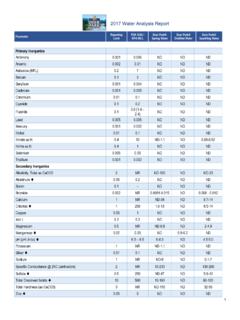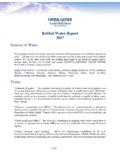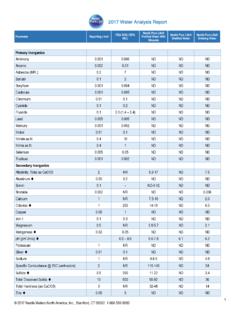Transcription of eSpring Contaminant Reduction List 03012017 - …
1 Prepared by Research & Development Revised 03/01/17 RM eSpring Contaminant Reduction List (Including Health Effects & Sources of Contamination) # Contaminant CAS Number % Reduced Potential Health Effects from Ingestion of water Sources of Contaminant in drinking water 1 Acenaphthene 83 32 9 > Headache, fatigue, nausea; development of skin allergy; liver and kidney damage Runoff/leaching from use as insecticide/fungicide 2 Acenaphthylene 208 96 8 > See Above Dehydration of acenaphthene 3 Alachlor 15972 60 8 >95 Eye, liver, kidney or spleen problems; anemia; increased risk of cancer Runoff from herbicide used on row crops 4 Aldicarb 116 06 3 Central nervous system and neurological problems Runoff/leaching from soil treatment with insecticide 5 Aldrin 309 00 2 Increased risk of cancer Runoff/leaching from soil treatment with insecticide 6 Alpha BHC 319 84 6 > Liver and kidney damage; increased risk of cancer Runoff/leaching from insecticide 7 Alpha Endosulfan 959 98 8 Endocrine disruption Runoff from insecticide used on food crops8 Anthracene 120 12 7 > Skin damage, gastrointestinal tract; hematological and lymphoid systems problems Release from dye manufacturing or wood preserving facilities; runoff from insecticide use 9 Asbestos 12001 29 5 >99 Skin damage; circulatory system problems; increased Decay of asbestos cement in water mains; runoff from glass and electronics plant Prepared by Research & Development Revised 03/01/17 RM risk of benign intestinal polyps, lung disease and cancer wastes; wear/breakdown of asbestos containing materials; erosion of natural deposits 10 Atenolol 29122 68 7 99% Potential endocrine disrupting compound (EDC).
2 Group of drugs called beta blockers that works by slowing down the heart and reducing its workload drinking water contaminated by pharmaceuticals is an emerging area of research. The levels that are being reported are in the parts per trillion (ppt) ranges but are still alarming to many people even though there is no reported health effects associated to any of the levels of pharmaceuticals reported. 11 Atrazine 1912 24 9 >90 Cardiovascular system problems; reproductive difficulties; increased risk of cancer Runoff from herbicide used on row crops; leaching from wastewater at manufacturing sites 12 Benzene 71 43 2 >95 Anemia; decreased in blood platelets; increased risk of cancer Discharge from factories; leaching from gas storage tanks and landfills 13 Benzidine 92 87 5 > Increased risk of urinary bladder and other cancers Leaching from waste sites; breakdown of benzidine based dyes (breakdown of 1, 2 diphenylhydrazine) 14 Benzo[k]fluoranthene 207 08 9 Increased risk of cancer Leaching from waste sites of manufactured gas facilities; product of incomplete combustion of fossil fuel, organic matter, garbage 15 Benzo[a]anthracene 56 55 3 > Increased risk of cancer Leaching from waste sites of manufactured gas facilities.
3 Product of Prepared by Research & Development Revised 03/01/17 RM incomplete combustion of fossil fuel, organic matter, garbage 16 Benzo[a]pyrene 50 32 8 Reproductive difficulties; skin changes; increased risk of cancer Leaching from linings of water storage tanks and distribution lines 17 Benzo[b]fluoranthene 205 98 2 Increased risk of cancer Release from dye manufacturing or wood preserving facilities; product of incomplete combustion of fossil fuel, organic matter, garbage 18 Benzo[g,h,i] perylene 191 24 2 Possible skin, liver, and related tissue problems Product of incomplete combustion of fossil fuel, organic matter, garbage 19 Beta BHC 319 85 7 > Liver and kidney problems; increased risk of cancer Runoff/leaching from insecticide 20 Beta Endosulfan 33213 65 9 Endocrine disruption Runoff from insecticide used on food crops21 Bis(2 Chloroethoxy) methane 111 91 1 > Skin and eye irritations Discharge from rubber manufacturing plants 22 Bis(2 chloroethyl) ether (BCEE) 111 44 4 > Irritation and problems with skin, eyes, throat and lungs; increased risk of cancer Discharge from textile factories, pesticide manufacturing and industrial chemical factories 23 Bis(2 chloroisopropyl) ether 108 60 1 > Increased risk of cancer Discharge from dye, pharmaceutical and industrial chemical factories 24 Bis(2 ethyl hexyl) phthalate 117 81 7 Developmental, liver and gastrointestinal problems.
4 Increased risk of cancer Discharge during production of PVC and vinyl chloride resins 25 Bisphenol A (BPA) 80 05 7 A chemical compound used as a plasticizer Prepared by Research & Development Revised 03/01/17 RM 26 Bromochloroacetonitrile 83463 62 1 > Suspected carcinogen Byproduct of drinking water disinfection 27 Bromodichloromethane see Trihalomethanes (TTHM s) 28 Bromoform see Trihalomethanes (TTHM s) 29 4 Bromophenyl phenyl ether 101 55 3 > Leaching from waste sites 30 Butyl benzyl phthalate 85 68 7 > Reproductive and developmental problems; increased risk of cancer Release from PVC manufacturing facilities; leaching from waste sites 31 Carbamazepine 298 46 4 > An anti convulsant and mood stabilizing drug 32 Carbaryl 63 25 2 > Cholinesterase inhibition causing headaches, memory loss, muscle weakness and cramps; liver and kidney problems Leaching from soil treated with insecticide 33 Carbofuran 1563 66 2 >95 Problems with blood or nervous system; reproductive difficulties Leaching from soil fumigant used on rice and alfalfa 34 Carbon tetrachloride 56 23 5 >95 Liver problems; increased risk of cancer Discharge from chemical plants and other industrial activities 35 Chlordane 57 74 9 >95 Liver or nervous system problems.
5 Increased risk of cancer Residue from banned termiticide Prepared by Research & Development Revised 03/01/17 RM 36 Chlorobenzene 108 90 7 >95 Liver or kidney problems Discharge from chemical and agricultural factories 37 Chlorodibromomethane see Trihalomethanes (TTHM s) 38 2 chloroethyl vinyl ether 110 75 8 > Release during manufacture of pharmaceuticals 39 Chloroform see Trihalomethanes (TTHM s) or VOC s >95 Suspected carcinogen 40 4 Chloro 3 methylphenol 59 50 7 > Lung and skin problems By product of water chlorination treatment; discharge from waste waters at manufacturing facilities 41 2 chloronaphthalene 91 58 7 94 Used in solvent, wood preservatives, immersion oil for testing refractive index and as additives in cable insulation, engine oil, electroplating compounds and capacitors. They are used in producing dyes. Toxic Pollutants 42 2 Chlorophenol 95 57 8 > Reproductive and developmental problems; liver and kidney damage; increased risk of cancer Leaching from treated wood; release from manufacturing facilities 43 4 Chlorophenyl phenyl ether 7005 72 3 > Prepared by Research & Development Revised 03/01/17 RM 44 Chloropicrin 76 06 2 > Toxicity to humans, including carcinogenicity, reproductive and developmental toxicity, neurotoxicity and acute toxicity Runoff from use as pesticide and byproduct of drinking water disinfection 45 Chlorpyrifos 2921 88 2 > Cholinesterase inhibition causing nausea, dizziness, and confusion.
6 Nervous system problems Runoff from home insecticide use on cockroaches, fleas and termites or from farm use to control ticks on cattle and crop pests 46 Chrysene 218 01 9 > Increased risk of cancer Pollution of dust particles formed when garbage, gasoline, or animal and plant materials are burned 47 cis 1, 2 Dichloroethylene 156 59 2 >99 Kidney and liver damage; nervous and hematological system problems Discharge from industrial chemical factories 48 cis 1, 3 Dichloropropylene 10061 01 5 >99 Bladder and kidney damage Leaching from soil treated with nematocide; leaching from hazardous waste sites and production facilities 49 2 4 D 94 75 7 >95 Kidney, liver and hematological system problems Runoff from herbicide used on row crops 50 4, 4 DDD 72 54 8 97 Increased risk of cancer Residue from banned pesticide; leaching from landfills or waste sites 51 Delta BHC 319 86 8 > Liver and kidney problems Runoff/leaching from insecticide 52 Dibenzo[a,h] anthracene 53 70 3 Increased risk of cancer Leaching from waste sites of manufactured gas facilities; product of Prepared by Research & Development Revised 03/01/17 RM incomplete combustion of fossil fuel, organic matter and garbage 53 Dibromoacetonitrile 3252 43 5 > Suspected carcinogen Byproduct of drinking water disinfection 54 4, 4 Dibromo 1, 1 biphenyl 92 86 4 Weight loss, skin disorders, liver, kidney, thyroid gland and nervous and immune system problems; increased risk of cancer Leaching from landfills and waste waters from fire retardant and plastics manufacturing facilities 55 Dibromochloropropane (DBCP) 96 12 8 >95 Reproductive difficulties; kidney damage.
7 Increased risk of cancer Runoff/leaching from use as a nematocide for soil fumigant 56 Dichloracetonitrile 3018 12 0 > Suspected carcinogen Byproduct of drinking water disinfection 57 o Dichlorobenzene 95 50 1 >95 Liver, kidney or circulatory system problems Discharge from industrial chemical factories 58 1, 3 Dichlorobenzene 541 73 1 > Liver and kidney damage Discharge from industrial chemical factories 59 p Dichlorobenzene 106 46 7 >98 Anemia; liver, kidney or spleen damage; changes in blood Discharge from industrial chemical factories 60 3, 3 Dichlorobenzidine 91 94 1 > Dermatitis; increased risk of cancer Discharge from industrial chemical factories 61 1, 2 Dichloroethane 107 06 2 95 Increased risk of cancer Discharge from industrial chemical factories 62 1, 1 Dichloroethylene 540 59 0 >99 Liver damage Discharge from industrial chemical factories Prepared by Research & Development Revised 03/01/17 RM 63 2, 4 Dichlorophenol 120 83 2 > Liver and kidney damage.
8 Nervous and immune system effects Discharge from pesticide manufacturing factories 64 1, 2 Dichloropropane 78 87 5 >99 Increased risk of cancer Discharge from industrial chemical factories 65 1, 1 Dichloropropanone 513 88 2 >98 Suspected carcinogen Byproduct of drinking water disinfection 66 Dieldrin 60 57 1 Increased risk of cancer Runoff/leaching from soil treatment with insecticide 67 Diesel Fuel 68 N,N Diethyl meta toluamide (DEET) 134 62 3 > A pesticide and common active ingredient in insect repellents 69 Diethyl phthalate 84 66 2 > Leaching from plastics during use and from waste sites and landfills containing discharge plastics 70 2, 4 Dimethyl phenol 105 67 9 > Liver and kidney damage; hematological and nervous system problems Discharge from industrial chemical and petroleum factories 71 Dimethyl phthalate 131 11 3 > Reproductive problems; kidney damage Discharge from industrial chemical factories 72 Di n butyl phthalate 84 74 2 > Possible reproductive problems (when large quantities are ingested) Discharge from industrial chemical factories 73 4, 6 Dinitro 2 methyl phenol 534 52 1 > Central nervous system and cardiovascular problems; cataracts; skin irritations; kidney and liver damage Discharge from industrial chemical factories; leaching from landfills and use as a pesticide Prepared by Research & Development Revised 03/01/17 RM 74 2, 4 Dinitrophenol 51285 > Nausea, vomiting, sweating, dizziness, headache, loss of weight Pesticide runoff to water and from releases to the air from manufacturing plants 75 2, 4 Dinitrotoluene 121 14 2 > Hematological and nervous system effects.
9 Increased risk of cancer Discharge from industrial chemical factories and manufacturing processes such as polyurethane, ammunition and dyes 76 2, 6 Dinitrotoluene 606 20 2 > See above See above 77 Di n octyl phthalate (DNOP) 117 84 0 > Possible liver damage Release during manufacturing; leaching from plastic during use or in landfills 78 Dinoseb (DNBP) 88 55 7 99 Reproductive difficulties Runoff from herbicides used on soybeans and vegetables 79 1, 2 Diphenylhydrazine 122 66 7 > Increased risk of cancer Leaching from waste sites 80 Ethinyl Estradiol (17 alpha ethynyl estradiol) or EE2 77538 56 8 98 Potential endocrine disrupting compound (EDC) Component of combined oral contraceptives 81 Endosulfan sulfate 1031 07 8 Liver, kidney and reproductive damage; endocrine disruption Breakdown of alpha and beta endosulfan isomers 82 Endrin 72 20 8 >95 Liver problems; nervous system effects Residue of banned insecticide 83 Endrin aldehyde 7421 93 4 > Breakdown of endrin 84 Estrone 53 16 7 > A prescription birth control drug in the pharmaceutical drug category 85 Ethylbenzene 100 41 4 >95 Liver and kidney damage Discharge from petroleum refineries Prepared by Research & Development Revised 03/01/17 RM 86 Ethylene dibromide 106 93 4 >95 Problems with liver, stomach, reproductive system and kidneys; increased risk of cancer Discharge from petroleum refineries 87 Flouranthene 206 44 0 > Liver and kidney damage; increased risk of cancer Release from dye, pharmaceutical, and agrochemical manufacturing facilities 88 Fluorene 86 73 7 > Hematological effects Release from dye, pesticide, thermoset plastic and pharmaceutical manufacturing facilities 89 gamma BHC (Lindane) 58 89 9 >95 Liver and kidney damage.
10 Increased risk of cancer Runoff/leaching from insecticide 90 Gasoline 91 Guthion 86 50 0 > Nervous system problems; personality changes Runoff/leaching from insecticide 92 Heptachlor 76 44 8 >95 Liver and central nervous system damage; increased risk of cancer Residue from banned termiticide 93 Heptachlor epoxide 1024 57 3 >95 Liver damage; increased risk of cancer Breakdown of heptachlor 94 Hexachlorobenzene 118 74 1 > Liver and kidney damage; reproductive difficulties; benign tumors of endocrine glands; increased risk of cancer Discharge from metal refineries and agricultural chemical factories 95 Hexachlorobutadiene 87 68 3 >98 Kidney and liver damage; increased risk of cancer Discharge from industrial chemical factories Prepared by Research & Development Revised 03/01/17 RM 96 Hexachlorocyclopentadiene 77 47 4 >99 Kidney and stomach da









